What the heck is an ‘Altered Reality’, you say?
At present I spend most of my time on my Kamvas Pro 24 Huion pen tablet creating digital art. My compositions combine photography and hand drawing to create a bit of mystery, or a feeling of nostalgia. I use only my own photos, my own art and drawing skills to create my vision. No AI, and no borrowing others’ images. The art that results I call my “Altered Reality” series.
Where it all started
I have been an artist all my life. Starting like any other toddler, I like to scribble… although as both my grandmothers and my parents can attest to, I scribbled constantly. Get a writing instrument in my hands and I was off to find something to scribble on.
It just went up from there. Throughout the years I learned to work in almost every art medium there was. Even today, if you walked into my studio, you’d find every kind of tool and equipment available to make anything you’d ever want. As a friend of mine once stated, the first time she saw my studio, “It’s like Disneyland for artists!”
I don’t know if I suffer from undiagnosed ADHD, or if I just have a thirst for knowledge, but here I am casting a very wide net as an artist. Professionally, I have been a graphic designer, illustrator, portrait painter, mural artist, China painter, photographer and digital artist.
I am a painter of oils, watercolors and acrylics, drawer in pastels, charcoals and graphite, skilled in photography, printmaking, typography, ceramics, stained glass, leather tooling and even tried my hand at glassblowing and bronze casting. I am skilled at sewing, mechanical drawing and Oh, and I’ve been an art teacher from kindergarteners to college level, (mostly high school and college) for the last 30+ years.
Somewhere in the late 1990s I took an interest in a fairly new program called Adobe Photoshop. Before that I worked with a machine about the size of a car that could print out logos and type that I would cut out, wax the back and align it on an illustration board for creating pages for magazines and ads. That was back in the 1970s.

Introducing “Idle Gossip”
“Idle Gossip” is one of the artworks in my Altered Reality series. It is a picture of chickens hanging around the yard visiting with each other. They appear to be gossiping. The imagery of women gossiping over a fence is an old tale. Even back a few generations, gossiping women were referred to as “hens”, so this composition is not a stretch of the imagination. I love chickens. They are so expressive. This particular Altered Reality came easy as a composition and finished artwork. Not every artwork I create is an easy process.
The Sketch
I start, like most traditional paintings… with a sketch of the basic idea. I don’t try to make a finished drawing; I just play with different ideas until I like the balance and feel of the piece. I find it unnecessary to sketch the chickens in detail, since I will be taking photos of the chickens, not drawing them from scratch. I also don’t apply any color to my sketches. They are just quick sketches to show the composition, although at times I will map out the shadows if they are critical to the composition. Idle Gossip is not one of those.

Taking Photos
Determining the composition is of utmost importance before taking the photographs needed for the artwork. Without the composition, I wouldn’t know at what angle I should be taking the photos. Am I looking at the chickens from their eye view or mine? Do I need an overhead shot of them? Should the photos be of them running or standing still? How many chickens do I need?
Chickens aren’t the only things I need to photograph. What kind of background do I need to include?
In this composition, I needed a solid wooden fence and a long log. However, I didn’t know I was going to need the log, so I didn’t get a picture of one. Instead, I had to improvise. More on that later.
Rarely do I have exactly what I need in my photo archives so I end up taking photos specifically for the artwork in mind. So off to a farm I go! Actually, these hens came from two different photo shoots at two different farms because I wanted each hen to be a different breed. The farms were in opposite directions, over an hour away each…so two days of shooting and lots of gas, just for the chickens.
I was lucky enough to have a wooden fence that I could use in my archives and decided to wing it with whatever else I needed as an image. The composition was simple and I thought I’d take advantage of that and stay in the studio.
The Selection Process
I learned the traditional method used during the Renaissance on how to create an oil painting. I don’t see that much anymore and in another post I’’ go over that, but for now let me just say that if I was painting this scene, I’d start with staining the background and then build the background and then the subject matter slowly with layers of paint.
Digitally, it doesn’t matter if you start with the chickens or the background. Everything has its own layer and so it is easy to create from any starting point you want. I’m not consistent on this. It depends on the composition, With Idle Gossip I stared with the chickens, then figured out what looked good behind them.
I went through hundreds of photographs taken over the course of those couple of days. I find my rate of picture taking is about 70-100 photos an hour. Not like the old days before digital when each photo was precious since the max was 36 photos on a roll. Today, it is so much simpler.
Going through them, I was looking for, first and foremost, the photos that were spot on, sharp, in focus and taken close enough for outstanding detail in the feathers, etc. No matter what perfect position the chicken is in, if she is not in focus, the photo is useless to me as a subject of the composition. If I liked a particular chicken’s position, then I’d look for that same position in the other photos in an attempt to find it in sharp focus.
I needed five hens in varying positions, and each a different color, facial expression, etc. so that each one looked like an individual. They also had to be in positions where they looked like they were talking to each other. To figure out who went where, I picked my favorites and put them in a folder for easy access.
Setting the Scene
I opened up my favorite five choices. With each photo I used the lasso tool to roughly circle the chicken and then brought her into the blank page in Photoshop. I most often start with a canvas size of 24”x36” at 360ppi. I work big.
From there I move each one around in position and see who will be standing where, keeping in mind that each head must look as if she is listening or talking within the cluster. This process can go on for quite some time. Choosing the right hen is critical. I’ll find one or two that fit in nicely, then I go back into the folder and find another one or two and try them out. I cannot just bring in the entire picture because it makes it too hard to figure out the connection between the hens, so each hen gets lassoed out of her photo just as I did with the first ones.
More than likely, I’ll find a chicken I like better than the first few, but it changes the dynamic between them and then I have to replace a couple that I had already determined on. This switching back and forth is time consuming, but finally I’ll get the composition the way I want it.
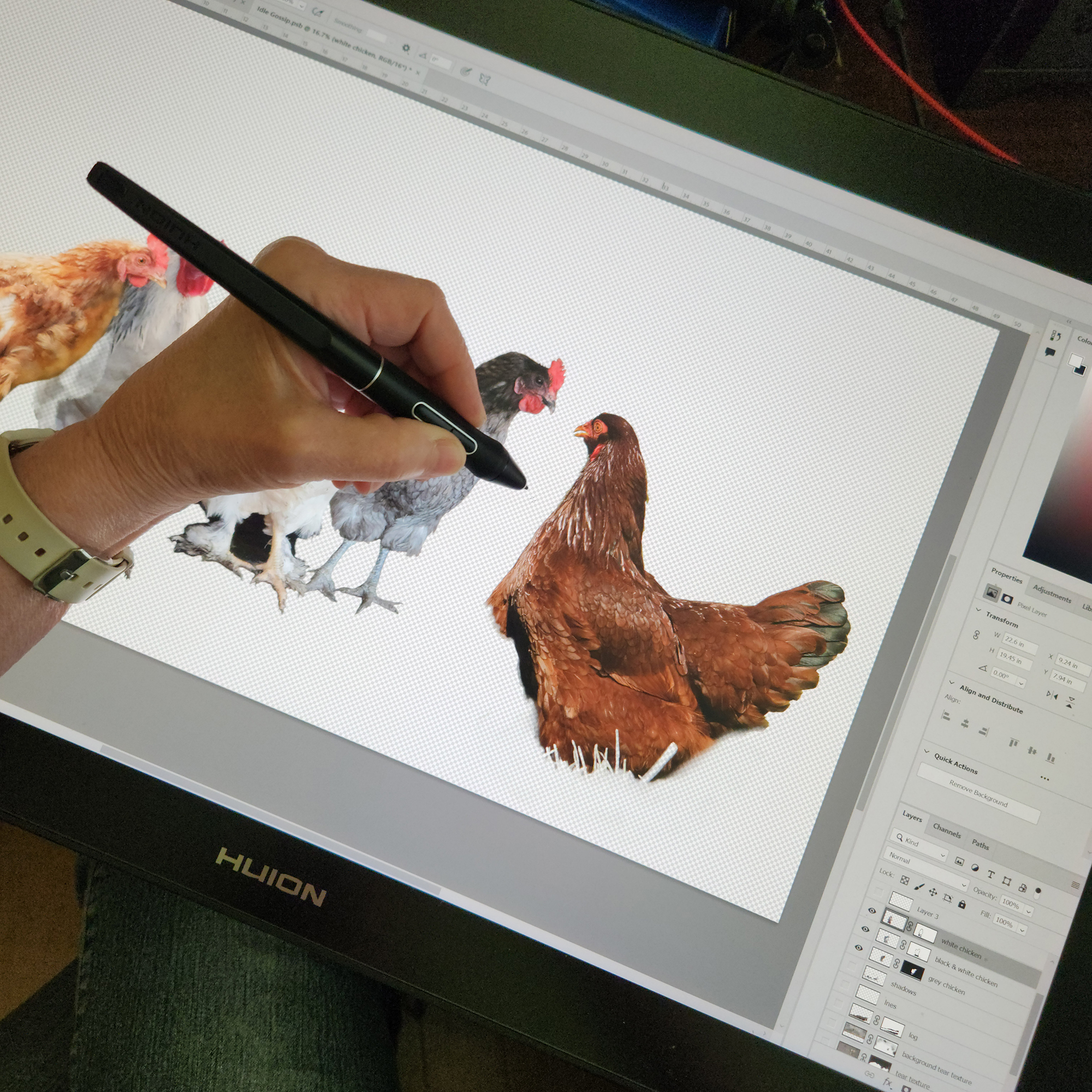
Silhouetting the Hens
After deciding on which hens to use I go back and silhouette each one of them. The background they came from is not being used so I have to totally remove anything that isn’t a part of the chicken. Each hen goes through the same process of blowing it up to a huge size in the monitor, adding a layer mask and then carefully painting out the background. I do not let the program mask my subjects because the hens are usually in an environment where they blend into the background in parts and I find I spend more time trying to figure out what the program missed or took too much away than just going around doing the process myself.
I use a small, soft paintbrush to make the edge look realistic. It is time consuming, but then I know it is done right. Too many times I relied on the masking program and was left with a mess. Once that is done I walk away from the Altered Reality for a day or two.
When I come back, I’m looking at it with a fresh eye and the results from the session before may need tweaking.
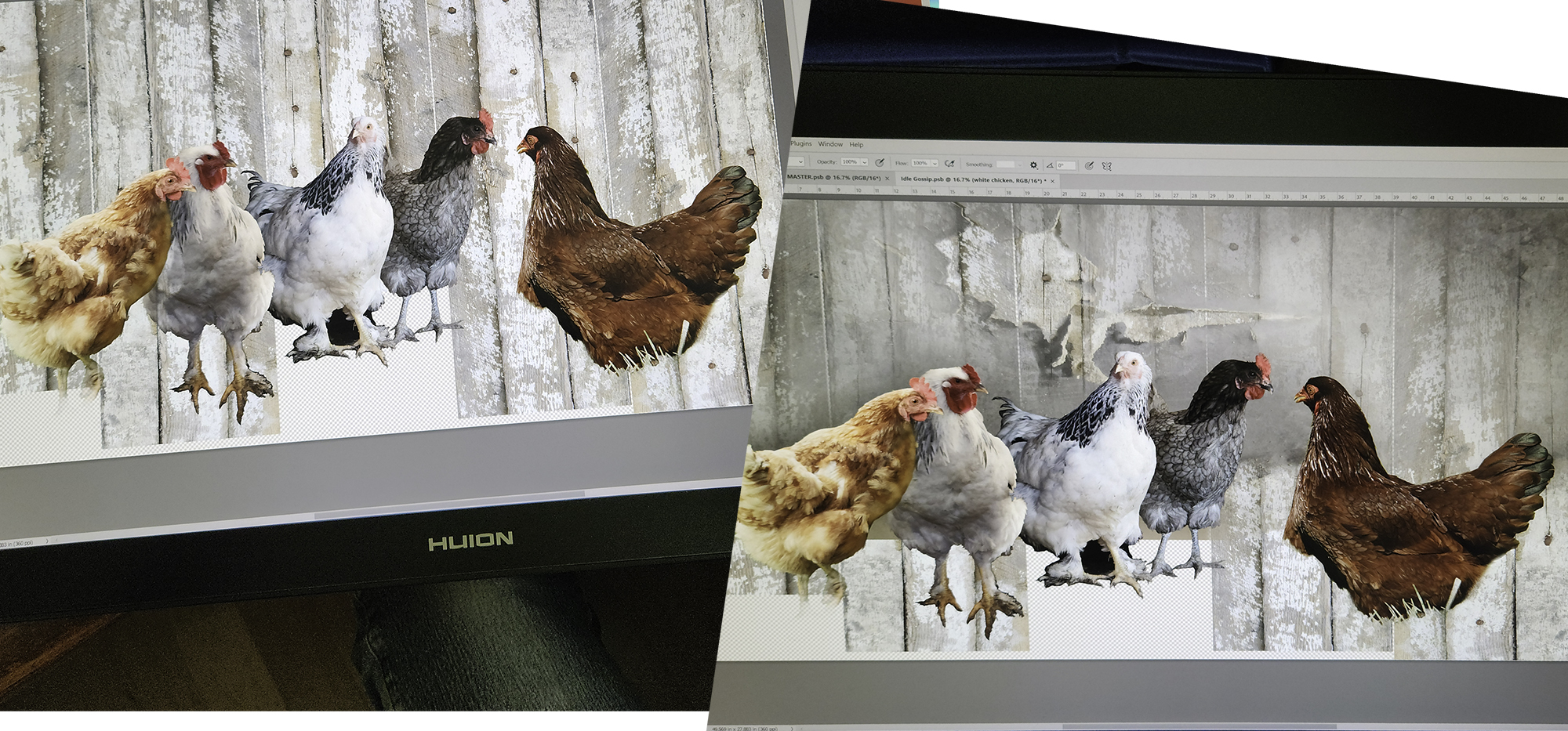
Adding the Fence
The wood fence came next. I had quite a few wood fence photos and started putting each one in the background to get the right color, texture and tone that looked best. You can’t tell until you try them out.
I decided on a grey fence. The color worked well for the varied colors of my hens and the texture complimented the scene. Unfortunately, I didn’t have enough of the fence so I had to repeat it to fill in the area completely. You can’t just copy paste, because a persons’ eyes will readily pick up any repetition in a pattern. Reversing the picture doesn’t usually work either, because we are designed to pick up patterns whether they are in reverse, upside down or whatever…we spot it. So I had to disrupt the image by manipulating the texture and literally painting some different boards so there was no repetition.
Then I added some “peeling paint” from another photo (which actually wasn’t peeling paint) and gradually blended into the fence, added shadows and lightened the inner part. This gave additional interest and solved the problem of the fence being too flat and uninteresting without distracting from the hens.
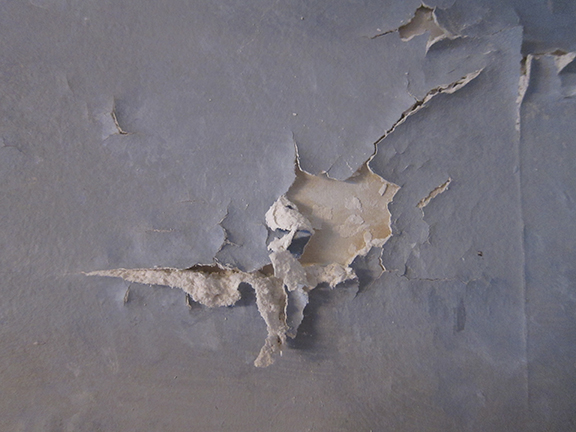
Solving a Problem of Chicken Feet
Since some of the hens were originally on a perch when I took their photo, I had the choice of manipulating their feet to look like they were standing on the ground or add a perch for them. I didn’t like the idea of a perch because it would change the height of the hens and then the head positions would no longer work. I had to think of something that they could stand on that was low and made since to the rest of the environment. A log seemed to make sense for a chicken yard, but I didn’t have any logs that were thin and long, so I look through hundreds of tree photos for a branch that was long and straight. Found it! Cut it off the tree and set it in place.
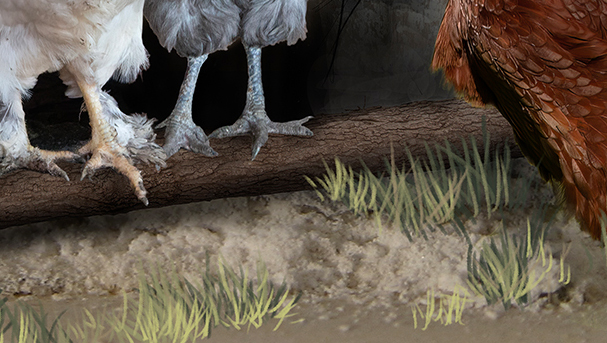
Now For the Ground
My next problem was the ground. I didn’t like the original ground, so I found a picture I took that looked like sand. It was, in reality, a picture of a plasterboard wall that was falling apart from water damage, but no one can tell. That became the ground. Remember the “peeling paint” that was added to the fence? That was another part of my water damaged plasterboard wall.
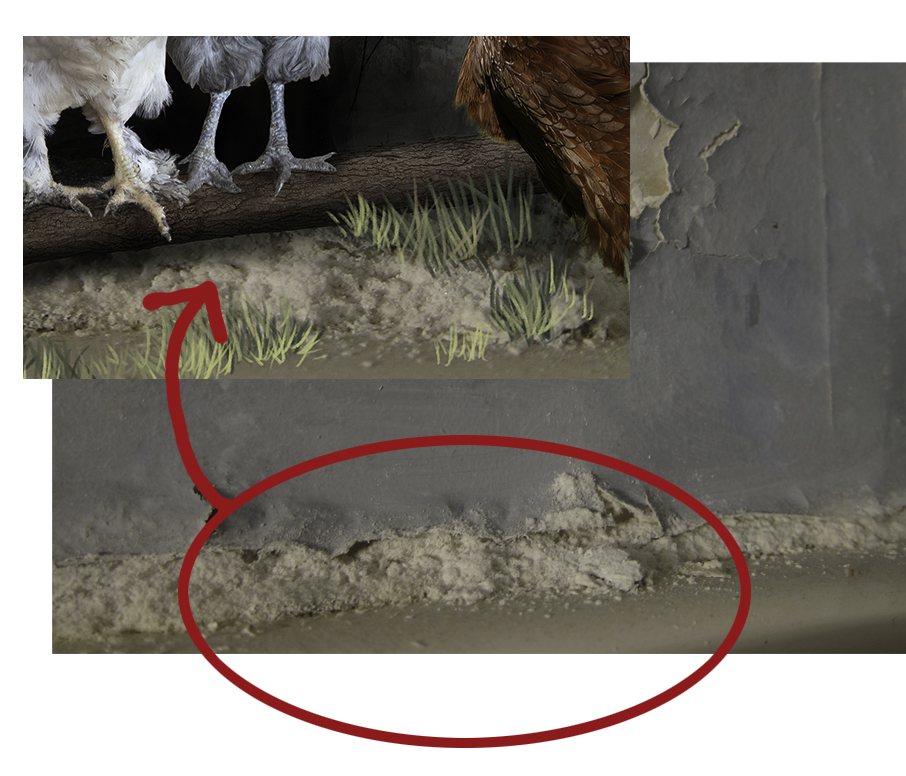
Shading and Shadows
I added shadows behind the hens, on the hens and the ground by drawing them in with my pen tool, adding some blur, then painting in some more for a natural looking depth. Additional highlights and shading was drawn into the feathers accentuating the form of the hens. I had to adjust these quite a bit to make sure the hens looked like they were in the same light, and that shadows from one were cast onto the other. Remember… each hen came from a different photo, so when you are compositing a scene, the lighting most likely will be off. This is why I call my art, Altered Reality! There’s definitely a lot to alter here.
Adding Grass
I needed grass, so that was painted in using a paintbrush that is pressure sensitive so the lines wouldn’t look mechanical. I started with a dark green color and then built up each layer of grass with a lighter color to get a natural looking shading and highlight to each leaf of grass.

Finishing Touches
This Altered Reality picture still needed a bit more action to it, so the last thing I did was add some fine sketchy lines that look like graphite. You can see those are roughly tracing the hens in a quick, scribbling action.
The final part is making sure the picture is cropped to its’ best ratio. The 24”x36” format doesn’t work for every composition. I use it only as a starting point. Once cropped, my signature gets added and the picture is ready to sell.
I Meet a Great Person
Just days after “Idle Gossip” was added to my website, the first sale of this Altered Reality went to a delightful woman in Tennessee who had a flock of Guinea Fowl. In a conversation we had together, she described her guinea hens getting together to gossip every time someone pulled into the driveway or something new was going on around them. She said that “Idle Gossip” reminded her of her hens, so she just had to have it! Can’t you just imagine those Guinea Hens? I imagine them every time I look at my “Idle Gossip” and it brings a smile to my face.

Conclusion
As you can see, creating an identical oil painting compared to creating an Altered Reality artwork may actually be easier!
If I can’t photograph the image I want, the Altered Reality does not get made. Whereas I am skilled enough to paint a hen as realistic as the photographs I use. But, like I said in the beginning, I LOVE working in a variety of media.



0 Comments